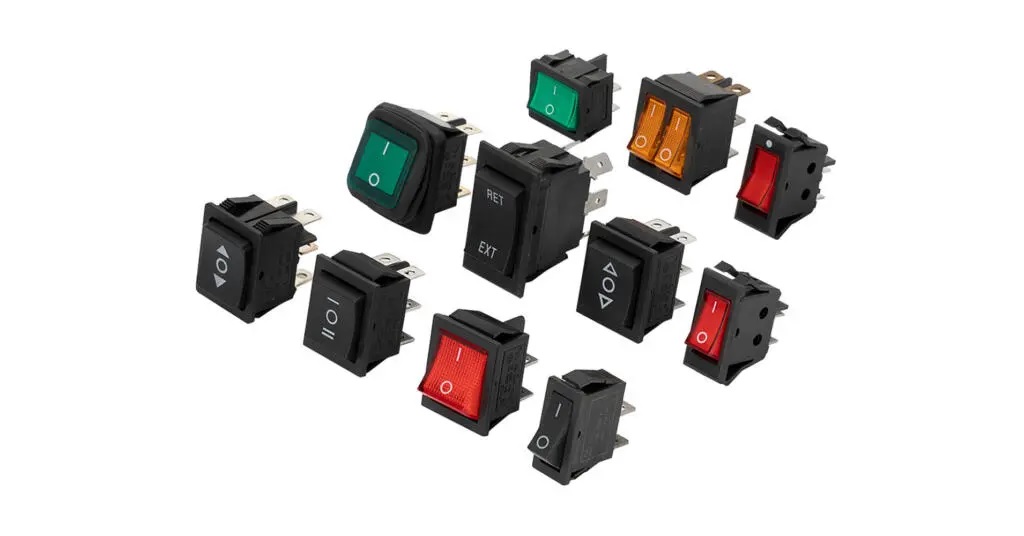Rocker switches are widely used electrical devices known for their simple on/off operation. Named after their rocking motion, these switches have one side that depresses when the other side is raised, functioning similarly to a seesaw. They’re often chosen for their durability, compact design, and ease of use. Whether in household appliances, industrial machinery, automotive dashboards, or marine equipment, rocker switches come in various forms tailored to specific functions and environments.
In this article, we’ll explore the different types of rocker switches and their common applications to help you understand which type is suitable for your particular needs.
- Single Pole Single Throw (SPST) Rocker Switch
Description: The SPST rocker switch is the most basic type. It controls a single circuit and has two terminals. It either connects or disconnects the circuit, offering a simple on/off functionality.
Applications:
- Table lamps
- Power supplies
- Basic control panels
- Small home appliances
This switch is ideal for basic operations where only one circuit needs to be controlled.
- Single Pole Double Throw (SPDT) Rocker Switch
Description: The SPDT switch has three terminals and can connect one input to either of two outputs. This allows it to switch between two different circuits or routes.
Applications:
- Fan speed selectors
- Motor controls
- Toggle lighting systems (like alternating between two light sources)
SPDT rocker switches offer slightly more functionality than SPST and are used where control over two circuits is necessary.
- Double Pole Single Throw (DPST) Rocker Switch
Description: A DPST rocker switch controls two separate circuits simultaneously. It has four terminals—two inputs and two outputs. Both circuits are switched on or off together.
Applications:
- Industrial machines requiring simultaneous power cuts
- Electric heating systems
- Appliances with dual-phase power
DPST switches are useful when there’s a need to control two independent circuits with a single toggle.
- Double Pole Double Throw (DPDT) Rocker Switch
Description: The DPDT switch functions like two SPDT switches operated by a single mechanism. It can connect two inputs to two outputs and toggle between them.
Applications:
- Reversing motor directions
- Complex control circuits
- Marine and automotive systems
DPDT rocker switches are versatile and ideal for applications requiring alternate routing of electrical flow in multiple circuits.
- Momentary Rocker Switch
Description: Unlike standard switches that stay in position, momentary rocker switches return to their original state when released. They function like push buttons, only completing a circuit while being pressed.
Applications:
- Horns
- Reset switches
- Starter buttons
These are typically found in applications requiring temporary activation of a device or function.
- Illuminated Rocker Switch
Description: Illuminated rocker switches feature a built-in LED or neon light that glows when the switch is on. This provides a visual cue to indicate whether the circuit is active.
Applications:
- Power strips
- Home theater systems
- Automotive dashboards
The illumination helps users quickly assess the status of connected devices, especially in low-light conditions.
- Sealed Rocker Switch
Description: These are rugged switches sealed against dust, moisture, and other environmental contaminants. They are typically rated with IP (Ingress Protection) codes to indicate their resistance level.
Applications:
- Marine equipment
- Outdoor installations
- Industrial machinery in dusty or wet environments
Sealed rocker switches are vital where durability and environmental resistance are essential.
- Custom-Printed or Laser-Etched Rocker Switch
Description:
These switches are tailored for specific applications and come with custom labels, symbols, or icons to indicate their function clearly.
Applications:
- Boat control panels
- RV and truck dashboards
- Medical equipment
Customization improves user interface and minimizes confusion, particularly in complex control systems.
Choosing the Right Rocker Switch
When selecting a rocker switch, consider the following factors:
- Current and Voltage Ratings: Ensure the switch can handle the electrical load.
- Number of Poles and Throws: Determine the complexity of the circuit control required.
- Mounting and Panel Cutout Size: Match with the enclosure or panel design.
- Environment: Use sealed switches for outdoor or harsh conditions.
- Safety Certifications: Look for UL, CE, or other regulatory approvals.
Final Thoughts
Rocker switches are diverse, with variations suited for nearly every industry and purpose. From simple SPST switches in household appliances to DPDT options in industrial settings, understanding the types and applications can help you select the right switch for your project. Whether you’re managing electrical systems in a boat, vehicle, or factory, the right rocker switch improves usability, enhances safety, and ensures efficient operation.
By identifying your specific needs and the operating conditions, you can make an informed choice and ensure the longevity and reliability of your electrical systems.
